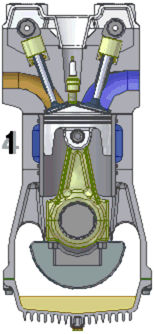
Four-stroke cycle used in gasoline and diesel engines
Today internal combustion engines in cars, trucks, motorcycles, aircraft, construction machinery and many others, most commonly use a four-stroke cycle. The four strokes refer to intake, compression, combustion (power) and exhaust strokes that occur during two crankshaft rotations per working cycle of the Gasoline engine and Diesel engine.
A four-stroke engine is characterized by four strokes, or reciprocating movements of a piston in a cylinder:
- intake (induction) stroke
- compression stroke
- power stroke
- exhaust stroke
In this example animation, the right blue side is the intake and the left yellow side is the exhaust. The cylinder wall is a thin sleeve surrounded by cooling water.
The cycle begins at top dead center (TDC), when the piston is farthest away from the axis of the crankshaft. On the intake or induction stroke of the piston, the piston descends from the top of the cylinder, reducing the pressure inside the cylinder. A mixture of fuel and air is forced (by atmospheric or greater pressure) into the cylinder through the intake (inlet) port. The intake (inlet) valve (or valves) then close(s), and the compression stroke compresses the fuel–air mixture.
The air–fuel mixture is then ignited near the end of the compression stroke, usually by a spark plug (for a gasoline or Otto cycle engine) or by the heat and pressure of compression (for a Diesel cycle or compression ignition engine). The resulting pressure of burning gases pushes the piston through the power stroke. In the exhaust stroke, the piston pushes the products of combustion from the cylinder through an exhaust valve or valves.